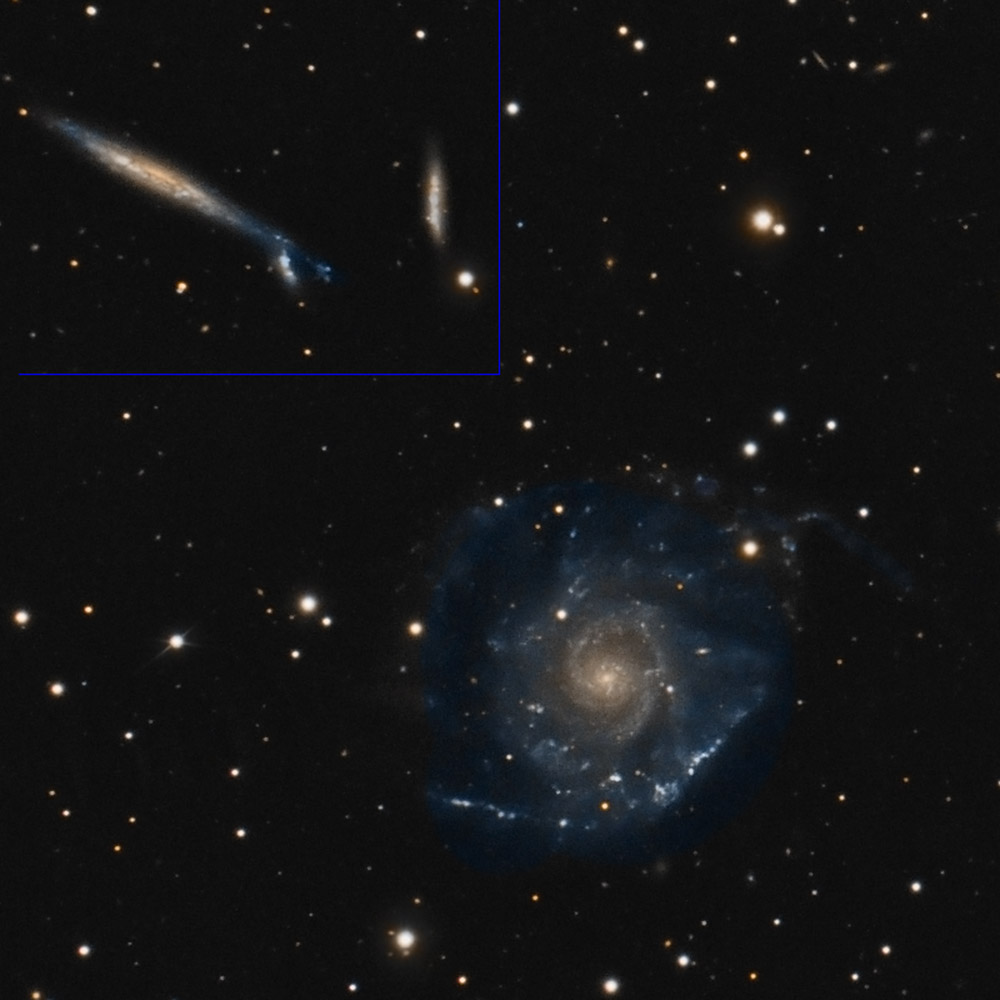| Description | Images |
Object name: NGC2805Designation(s): NGC2805, NGC2814, NGC2820, IC2458, HOLM 124 is a group of 4 galaxies in eastern Ursa Major, southeast of M81 and M82. At one time it was considered part of the M81 group but then redshift and other distance determinations showed it much more distant at say 84 to 100 million light-years. The main galaxy in the group is NGC 2805. It shows a lot of distortion from its interaction with the others three millions of years ago. Its arms are quite angular except in the core region. Most edges are linear rather than curved and it has some rather odd arms such as the spur to the west coming from its northern end. Other arms show lots of star-forming regions that NED shows as other galaxies except for one labeled Part of Galaxy (PoG). I've shown them in the annotated image but since their redshift matches that of the galaxy they are unlikely separate galaxies. The galaxy is quite blue, likely due to all the star formation going on in it. Related Designation(s):2MASS J09202045+6406105, 2MASS J09211139+6415132, 2MASS J09211144+6415121, 2MASS J09213011+6414189, 2MASS J09214548+6415284, 2MASX J09202040+6406099, 2MASX J09211152+6415117, 2MASX J09213008+6414195, 2MASX J09214556+6415288, 2MFGC 07261, 2MFGC 07265, 2MFGC 07269, ASK 446442.0, ASK 446446.0, CGCG 0916.3+6419, CGCG 0917.1+6428, CGCG 0917.5+6427, CGCG 0917.8+6429, CGCG 312-002, CGCG 312-003, CGCG 312-004, CGCG 312-005, CGPG 0917.5+6427, CXOU J092020.6+640607, EON J140.442+64.258, FGC 0877, GALEXASC J092130.07+641419.0 , HDCE 0520 NED001, HDCE 0520 NED002, HDCE 0520 NED003, HIJASS J0920+64, HOLM 124A, HOLM 124B, HOLM 124C, HOLM 124D, IC 2458, IC2458, IRAS 09162+6418, IRAS 09170+6428, IRAS 09177+6428, IRAS F09162+6418, IRAS F09177+6428, KTG 23A, KTG 23B, KTG 23C, LDCE 0635 NED001, LDCE 0635 NED002, LDCE 0635 NED003, LGG 173:[G93] 001, LGG 173:[G93] 002, LGG 173:[G93] 003, LGG 173:[G93] 005, MCG +11-12-003, MCG +11-12-004, MCG +11-12-005, MCG +11-12-006, MRK 0108, NGC 2805, NGC 2805:[SMM2013] X-01, NGC 2814, NGC 2820, NGC 2820A, NGC2805, NGC2814, NGC2820, NSA 076834, NSA 135848, NSA 135851, NSA 157206, NVSS J092146+641526, PGC 026410, PGC 026469, PGC 026485, PGC 026498, RFGC 1537, SDSS J092020.38+640610.6, SDSS J092020.38+640610.7, SDSS J092130.07+641419.3, SSTSL2 J092111.35+641514.1, UGC 04936, UGC 04952, UGC 04961, UGCA 159, UZC J092020.4+640610, UZC J092111.5+641506, UZC J092130.2+641417, UZC J092145.3+641528, UZC-CG 096 NED01, UZC-CG 096 NED02, UZC-CG 096 NED03, UZC-CG 096 NED04, VII Zw 276, WBL 218-001, WBL 218-002, WBL 218-003, [H84a] 0917+645, [M98j] 064 NED01, [M98j] 064 NED02, [M98j] 064 NED03, [SMM2013] 113, | Permanent link: https://images.mantrapskies.com/catalog/NGC/NGC2805-NGC2814-NGC2820-IC2458/NGC2805L4X10RGB1X10CROP125.JPG |


